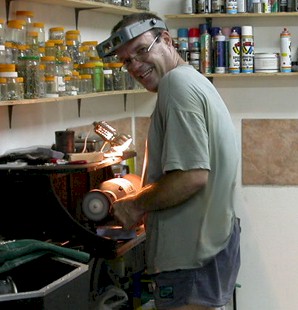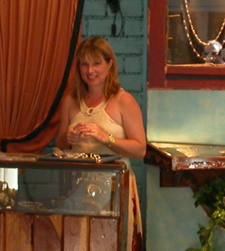ByElisenda Peters
With more gold and gemstones per square meter than any other place in the hemisphere, St Maarten is sometimes referred to as the jewellery capital of the Caribbean. It is certainly one of the most prolific items to be found around here. Even though our island enjoys a large jewellery, there is a gap when it comes to jewellery culture, according to African jewellery designer Hans Meevis. I'm amazed that there isn't a bigger industry of jewellery making here. "If people would just have the knowledge of how to make jewellery, then there certainly would be a market here," he said. Hans and his wife Anne own a jewellery store and studio in Philipsburg and recently started offering jewellery-making classes for beginners and advanced.
"I love jewellery, you couldn't put it out of me. I think it's important that you teach others," he said. Hans has been designing and making jewellery and cutting gemstones for over 25 years. According to him, there's a lot of secrecy in the jewellery industry, but a new online movement called "Ganoskin" has emerged with the mission to change that by creating a pool of information for the benefit of jewellers and craftsman free of charge. "It's a website where professional jewellers, like myself, give our knowledge for free. Secrecy must go away, there's no point in that. You get much more in return if your craft becomes open," he stressed. "I have the same attitude: I have no secrecy in jewellery, because nothing is new in jewellery. It was done 5000 years ago by the Egyptians," he added," he added.
To become a jeweller, you usually have to complete an an apprenticeship in jewellery for three to five years. "In this area of the
world that's not the case, therefore I started giving private lessons," he said. Hans' classes are taught individually and the price is US$25 an hour, which includes tools and materials. Officially jewellery-making classes start off with the theory, but Hans likes to put the theory into practice right away. "There is a lot of science involved. Buts it's difficult to start off with science first and then make it. It might put some people off and then they don't want to carry on," Anne explained. During the first lesson the student will learn how to make a simple silver band. Whereas in the United States jewellery students often start in bronze and copper, Hans prefers to use silver. "I prefer to start people in silver, because if you're going to make something you want something of value. It's nicer if you can walk away with silver then with bronze. You can always start in gold, and then you just pay extra for the weight of the gold," he said.
The lessons take place in three-hour segments. "During the first class, you'll learn how to melt the silver with a flame. Once you've cast your piece of metal, you go on to the "roller" machine, which forms the silver into whatever form you want it. Then we bend it round and close it. Then comes the difficult part of filling it and learning how to use all the different files and other tools," he explained. "It sounds easy, but it's not." Sometimes students have their very own idea of what jewellery they want to make. But when you come in here for the first time you have no choice," Anne said. "You've got no knowledge to say what you like in making, so we start with a simple band. You have to learn about the different equipment when and how you use them. The second set of lessons is more independent."
Hans is very pleased with the response to the jewellery making classes.
| If you would like to take jewellery-making classes or if you want more information on Meevis' jewellery, you cam contact them at 522-4434 or 522-4433. You can also visit their wenbsite ww.meevis.com |


"A good number of people came in for second and third lessons," he said. "Once you learn the basics, the jewellery bug bites you. It's like an addiction." Once students want to continue, they can set their own place up at home where they can practise. "It's nice when students get to that stage. I will help them by making the tools for them, as most equipment is expensive. Some machines are just to costly to invest in, like the roller. But in that case they can come to my studio and I will roll the metal for them or they do it themselves and go home to continue there," he explained. Once a student gets his or her own place the learning process will also become less expensive. "It's not reasonable to think someone is going to pay 25 dollars an hour for five years. You start first with the lessons and afterwards you practise by yourself. Then you only come in for certain specific handlings," Hans said.
If students become more advanced and are able to make their own designs and creations, Hans and Anne can put their pieces in the shop and sell them on the students' behalf. "That's also nice for them as it teaches them the business side of jewellery, which is important. It's all very well to do it for fun, but the object to teach somebody is for them to make money out of it," Hans emphasized. "It's important to have your outlet. It inspires people, because you know you can start living off your jewellery as well," Anne added. "You also get involved with how to sell, how to make your websites, and how to take pictures of your jewellery and so on. It all becomes integrated," she said. After a couple of years, a student can also get a certificate of competence. "We can teach everything, designing, drawing, gem cutting and setting, mass-producing, repairing, the whole lot. You can get a certificate in all of that, which can help you get a job in the industry," Hans said.
Classes can be taught to adults and children from 12 years onward. "If a kid starts learning at the age, it's excellent, because by the time you're 17 you've got an income. It's one thing to do it as a hobby, but I like to teach it as a business," Hans said. Hans and Anne have also taught jewellery making in Botswana, where they lived and owned two jewellery stores for 13 years. "In Botswana we taught the local people who were employed in our business. They were apprentices. Some of them turned out to be great jewellers. And that's nice," Hans said. Because of the unstable political situation of the neighbouring Zimbabwe, Hans and Anne decided to trade the African continent for the Caribbean. "We make artistic jewellery that tourists like buying. That market is pretty much in the Caribbean," said Anne. When we saw the green mountains of St Maarten we were sold!"
The jewellery pieces sold in the Meevis' shop are all custom-made. "I believe our shop is different. We don't sell standard jewellery, it ha a totally artistic inclination," Anne said. "That's what we like to do. There's such a nice tourist market here and tourists to buy jewellery and locally made crafts. So we really want to promote jewellery 'proudly made in St Maarten.' There is potential," Anne concluded.